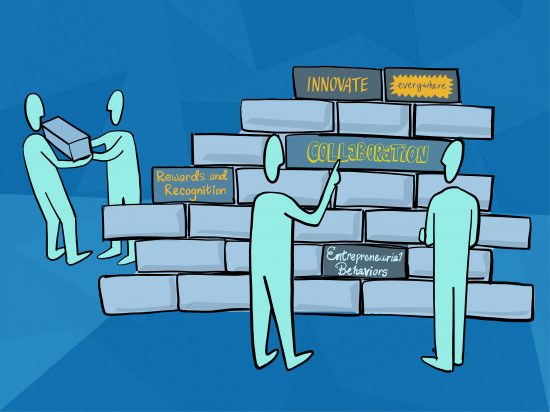In my previous blog, I shared four essential behaviours that leaders must employ to create a lasting, innovation-focused mindset amongst employees at every level of an organisation. In this blog, I explore four additional behaviours, which inspire employees to get behind the organisation’s innovation goals and work together to achieve them.
- Collaboration is ‘King’
It goes without saying that collaboration is a key part of any successful innovation strategy, but effective collaboration isn’t as easy as it may seem and requires skillful management. Innovation teams must be as diverse as possible, with each member selected for the unique attributes they bring to the table such as a particular skillset or area of expertise. Assembling teams from across the organisation helps to break down internal silos and encourage cross-departmental thinking that benefits multiple groups, not just a single entity. Also consider including customers and partners for further diversity to avoid “group-think” and ensure that problems being addressed are validated and the solutions created solve them.
- Rewards and Recognition Matter
An often-overlooked aspect of successful innovation strategy is that of rewards and recognition. Effective reward strategies don’t only focus on successful outcomes. Innovative behaviour and thinking is equally important and must be recognised as such. While not every idea will prove successful, encouraging and rewarding employees for thinking boldly and taking risks with their innovation ideas is the key to repeat behaviour. And it’s this repeat behaviour that ultimately leads to long-term culture change. Building innovation objectives and rewards into employee reviews will also help to maintain enthusiasm and ensure innovation doesn’t become just “another task” that needs to be addressed.
- Innovate Everywhere is the New Norm
Organisations must strive to keep innovation at the forefront of every employee’s mind if meaningful culture change is to be achieved. Instilling an innovate everywhere mentality is key. There are many ways that a leader can encourage this—from creating open working environments where new ideas can be explored without fear of failure to promoting a ”passionately dissatisfied” approach towards new or existing tasks. Idea generation may not be everyone’s strong suit, but innovation doesn’t begin and end with the initial idea. As a leader, you must encourage everybody to find ways to be involved. This could be refining ideas put forward by others, helping to connect teams, or simply shouting about an idea once it’s working. Remember that everything can be improved. It’s your job to ensure an environment is created that allows ideas to be freely exchanged and evolved.

- Entrepreneurship Fosters Success
Finally, leaders must encourage employees to adopt more entrepreneurial behaviours in both the approach to their own role and to the future of the wider organisation. This is best done by exhibiting those behaviours yourself. Experimentation is at the core of all successful entrepreneurialism. More often than not, the final outcome is a far cry from the original idea, so even project failures are learning experiences that should be celebrated and the lessons remembered. Providing incubation training, such as lean start up and formalising expected innovation behaviours will help employees understand what’s expected from them and how they can incorporate more entrepreneurial thinking into their day-to-day activity.
The eight key behaviours discussed over the past two blogs form the focal points for any successful innovation strategy. If your current strategy is failing, the chances are one or more of these behaviours has either been overlooked, or not implemented effectively.
In my final blog in this series, we’ll look back at what we’ve learned thus far and summarise what it means in practical terms for you as a leader.
it was my belief that CISCO leadership has learnt and taught innovation as part of their executive team DNA, reading Harvey’s blogs, confirms that. Harvey lists some key parameters that need to be tracked to really inculcate innovation in the team. I personally have learned a lot, thanks a lot for sharing.